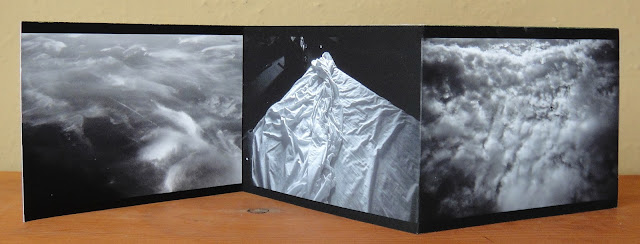T
wo fascinating 'cascading' accordions that take Galileo's drawings of the Sun's spots over the course of the year 1612 as their subject matter. Both accordions are accompanied with an information sheet about the work, with further detailed information on how they were published, and quite uniquely, suggestions on how to handle them, as per below:
"this cascading accordion will animate when played and physically animate our Sun's rotation. first, imagine your two hands resting side-by-side & holding a small book open across both hands. the white end pages, one in each hand, are the handles - squeeze hold of the outside edges or grab hold if needed. next, imagine your hands are on a vertical pulley, and will only move up and down but not side-to-side. understand that moving your hands apart horizontally will end in collapse. which is no big deal, part of getting started, easily remedied. somewhat like playing a slinky crossed with a flipbook."
For each of the two books featured here i'm going to reproduce the introductory texts that accompany each accordion, as they both give the fullest expression as to what Ocallaghan is trying to do with these unique works. Both accordions feature 35 drawings, across 70 single-sided pages, measuring 6 5/8" x 1 7/8", and when fully opened 10.75 feet.
Galileo's drawings of our Sun's spots (1612), 2021
Galileo Galilei (1564-1642) drew our Sun's spots at about the same time each day over the course of 37 days in June and July of 1612 (skipping two days and yielding 35 drawings). He could not look directly at our Sun without significant damage to this eyes. His solution was to use the latest technology - a telescope - to project an image of the Sun onto a piece of prepared paper. Galileo drew a circle with a compass and positioned the paper so that the Sun aligned with the circle, allowing him to draw in the sunspots from a consistent perspective each day. A casual review of these drawings makes evident that our Sun rotates, and at a much slower rate than the Earth's 24-hour cycle.
back cover
___________________________________________________
Our Sun's Spots (401 years after Galileo), 2021
Galileo Galilei drew our Sun's spots, at about the same time each day over the course of 37 days in June and July 1612 (skipping two days and yielding 35 drawings). a casual review of these drawings makes evident that our Sun rotates, and at a much slower rate than Earth's 24-hour cycle. NASA launched the Solar Dynamics Observatory (SDO) spacecraft to geosynchronous orbit (around Earth) in 2010. Atmospheric Imaging Assembly (AIA), onboard SDO, photographs our Sun every 15 minutes (24/7/365) using four multi-wavelength telescopic cameras (NASA posts images at SDO | Solar Dynamics Observatory
I selected 35 NASA photos of our sun (SDO/AIA 171), one per day around noon GMT, from June and July 2013, each image corresponding in date (+401 years) to one of Galileo's drawings; I inverted these images (making the sunspots black, like in Galileo's drawings); and I made 35 drawings of our Sun's spots (401 years after Galileo) based on these images. this cascading accordion presents 35 drawings, side-by-side, in sequence, across 70 pages.





















































